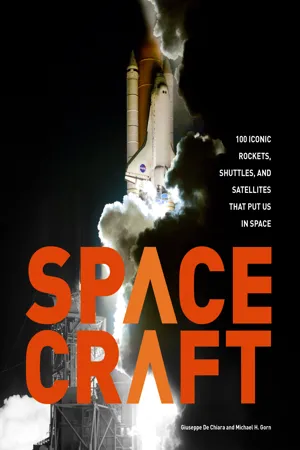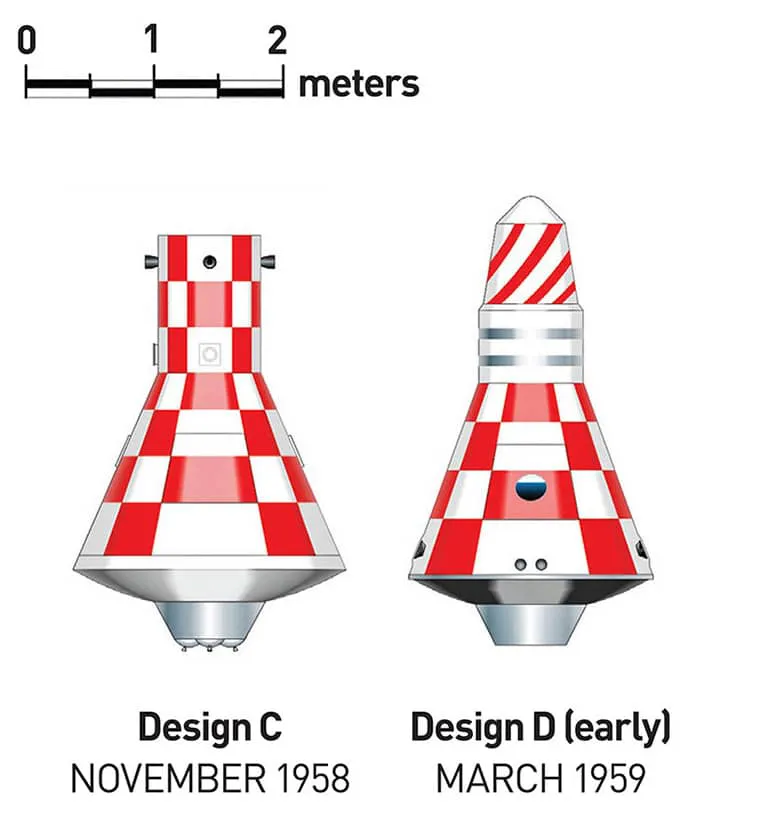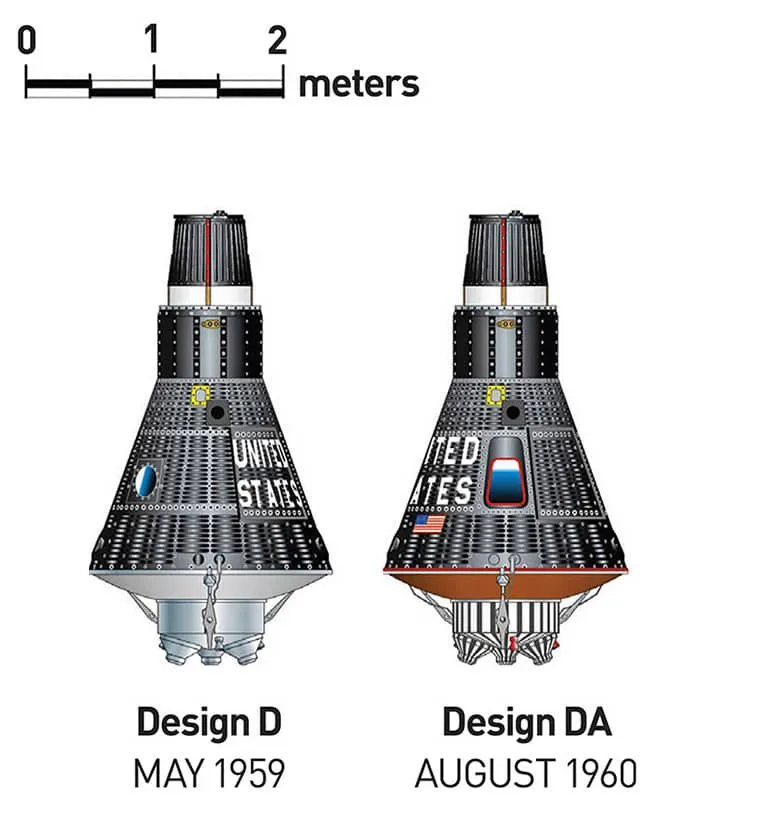1 THE FIRST SPACE AGE
1957–1977
CAPSULES
Mercury
NASA opened its doors on October 1, 1958, and the following month Project Mercury—named for the winged messenger of the gods in Roman mythology—got its start as the agency’s highest priority project. Before awarding the prime contract to McDonnell Douglas in 1959, the Space Task Group defined the capsule’s specifications: 6.8 feet (2 meters) long, 6.8 feet (1.9 meters) in diameter (at its base), and up to 3,000 pounds (1,400 kilograms) at launch. Stuffed to the limit with equipment, the interior furnished the sole astronaut with a tight, foam-fitted seat and just 36 cubic feet (1 cubic meter) of habitable volume—about the size of a two-cushion love seat. The capsule’s small size and low weight reflected the relatively weak thrust of its launch vehicles.
The Mercury spacecraft consisted of six main structural components: an escape tower for crew egress; an antenna housing at the top of the capsule; reentry parachutes in the narrow neck of the spacecraft; the crew compartment in the broad lower section; a heat shield below it; and the retrorockets at the very bottom. As initially conceived, the Mercury spacecraft’s flight path could only be guided from the ground. But in due course, the astronauts persuaded the designers to build cockpit controls, which in a few cases proved to be lifesaving.
Mercury experienced an unpredictable mixture of failure and success during the flight tests that preceded missions with astronauts on board. The first launch, in September 1959—a research and development mission—went aloft on an Atlas D missile and flew according to plan. But in July 1960, a ballistic-trajectory test of the Atlas missile/capsule combination ended in failure. The following November, the first of the numbered Mercury flights, known as Mercury-Redstone 1, also miscarried when its rocket engines shut down just after liftoff. The program recovered with a second attempt at Mercury-Redstone 1 in December 1960. The next month, NASA attempted to send a living creature into space—not an astronaut, but a chimpanzee named Ham, who flew on Mercury-Redstone 2. Ham survived some serious scares, enduring 17 gs at liftoff, an off-target splashdown, and a leaking spacecraft.
Mercury-Redstones 3 and 4 finally launched Americans beyond the confines of Earth, but not before Yuri Gagarin became the first man in space on April 12, 1961, on board a Vostok 3K spacecraft. The United States found itself behind the USSR after the launch of Sputnik I and three and a half years later still had much ground to gain. Gagarin had orbited the Earth for 108 minutes; Alan Shepard, who flew on May 5, 1961, aboard Mercury-Redstone 3 (better known as Freedom 7), made a suborbital leap into space that lasted a little more than fifteen minutes. His mission went off without incident, but that of Virgil “Gus” Grissom on July 21, 1961, on board Mercury-Redstone-4 (Liberty Bell 7) did not fare as well. After a similar fifteen-minute journey, he splashed down, but the spacecraft’s new explosive hatch cover unexpectedly blew open, filling the capsule with water and sinking it, leaving Grissom to swim to the surface, where a helicopter rescued him.
Despite the checkered record of the early Atlas launch vehicles, on February 20, 1962, NASA—under intense pressure to respond to Yuri Gagarin’s flight ten months earlier—took a calculated gamble and began the countdown on American orbital spaceflight. From the pool of applicants submitted in 1958, Robert Gilruth and the Space Task Group at NASA Langley chose fourteen for Astronaut Group 1, and from this number selected seven principals for Mercury. Among them was Marine pilot (later colonel) John H. Glenn for the first orbital flight. He served as a combat pilot during World War II and the Korean conflict, after which he attended the US Navy test pilot school.
Glenn went into orbit on Friendship 7/Mercury-Atlas 6 on February 20, 1962, and he accomplished his mission, but not without some nail-biting moments. Flying over Mexico, in his second orbit, he noticed a loss of attitude control; the automatic stabilization system failed to keep the capsule on course, causing it to drift to the right about 1.5 degrees per second. To compensate, for the rest of the flight he flew the spacecraft manually (proving the value of trained pilots in the cockpit). But as he crossed over Cape Canaveral, an equally dangerous problem threatened the mission: the heat shield had become unlocked, according to sensors. Unsure whether this reflected a crisis or a false alarm, Glenn received instructions to ignore procedure and refrain from jettisoning the retropackage after he fired the retrorockets during reentry, in the hope that the retropackage’s straps would hold the shield in place. As he descended into the atmosphere, everyone in ground control held their breath, but the mission ended safely after three orbits and nearly five hours in space. Glenn got lucky; the sensor had given an incorrect reading and the heat shield remained in place throughout the crisis.
McDonnell Mercury Spacecraft Design Evolution
McDonnell Mercury
Design D-1 “MR-3 Flight Configuration”
LEGEND
1 – T = 00:00 Launch
2 – T = 02:14 Lateral engines jettison
3 – T = 02:34 Escape tower jettison
4 – T = 5:00 Atlas rocket jettison
5 – T = 05:30 Capsule roll
6 – T = 6:00 Mercury in orbit
More tense episodes remained before Mercury ended. In May 1962, Scott Carpenter in Aurora 7/Mercury-Atlas 7 made a flight of similar duration to Glenn’s, but his capsule overshot the landing target by 261 miles (420 kilometers). Rescuers found Carpenter almost an hour after splashdown, sitting in a life raft after escaping from the capsule. Walter Schirra flew next aboard Sigma 7/Mercury-Atlas 8 in October 1962 and doubled the times logged in space by Glenn and Carpenter, making six orbits in more than nine hours with no incidents. At last, Gordon Cooper in Faith 7 lifted off atop Mercury-Atlas 9 in May 1963. This mission vastly expanded the range (and prestige) of the US space program. He remained in orbit for twenty-two revolutions, timed at thirty-four hours and twenty minutes. But some major troubles occurred. On the nineteenth orbit, an instrument light warned of deceleration and premature reentry; on the twenty-first, the automatic stabilization and system short-circuited and the carbon dioxide level rose in the spacecraft. Cooper took the controls, and, like Glenn, he flew his spacecraft to a safe reentry and splashdown.
Gemini
Although the early US space program seems, in hindsight, to run straight through from Projects Mercury to Gemini without interruption, in fact they had completely different origins and purposes. Mercury sprang from NASA’s predecessor, the National Advisory Committee for Aeronautics; Gemini originated with a speech made by President John F. Kennedy to Congress on May 25, 1961. Kennedy’s address came in response to when Soviet cosmonaut Yuri Gagarin became the first person in space on April, 1961, flying for 108 minutes in one orbit around the Earth. In sharp contrast, astronaut Alan Shepard made a short suborbital flight on May 5 that lasted slightly more than 15 minutes. The juxtaposition of these two space flights, separated by only twenty-two days, made it clear that the US remained far behind the USSR in space exploration, a serious deficiency at a time when the two superpowers vied for Cold War predominance.
The president asked the House and Senate for money (lots of money; he had been told that in the end it would cost about $33 billion) to land astronauts on the moon by the close of the 1960s. Congress approved, but the engineers and managers on Mercury realized that even if their project fulfilled its objectives, JFK’s towering new goal demanded that they overcome a big technological deficit. For one thing, although Mercury had dispelled many of the fears about the effects of space travel on human beings, it did not yield sufficient physiological information for prolonged moon shots. Additionally, no Mercury flight attempted extravehicular activities, or EVAs, essential to master before astronauts walked on the moon. Even more important, the rendezvous and docking of spacecraft, without which no lunar program could occur, had yet to be tried or tested. But most fundamental of all, no consensus existed in 1961 among NASA’s leaders about the overall architecture of the moon missions—how to send the astronauts there, how to land them, and how to bring them home.
Robert Gilruth and his Space Task Group at NASA Langley responded to Kennedy’s commitment by conceiving of Project Gemini, named for ...







